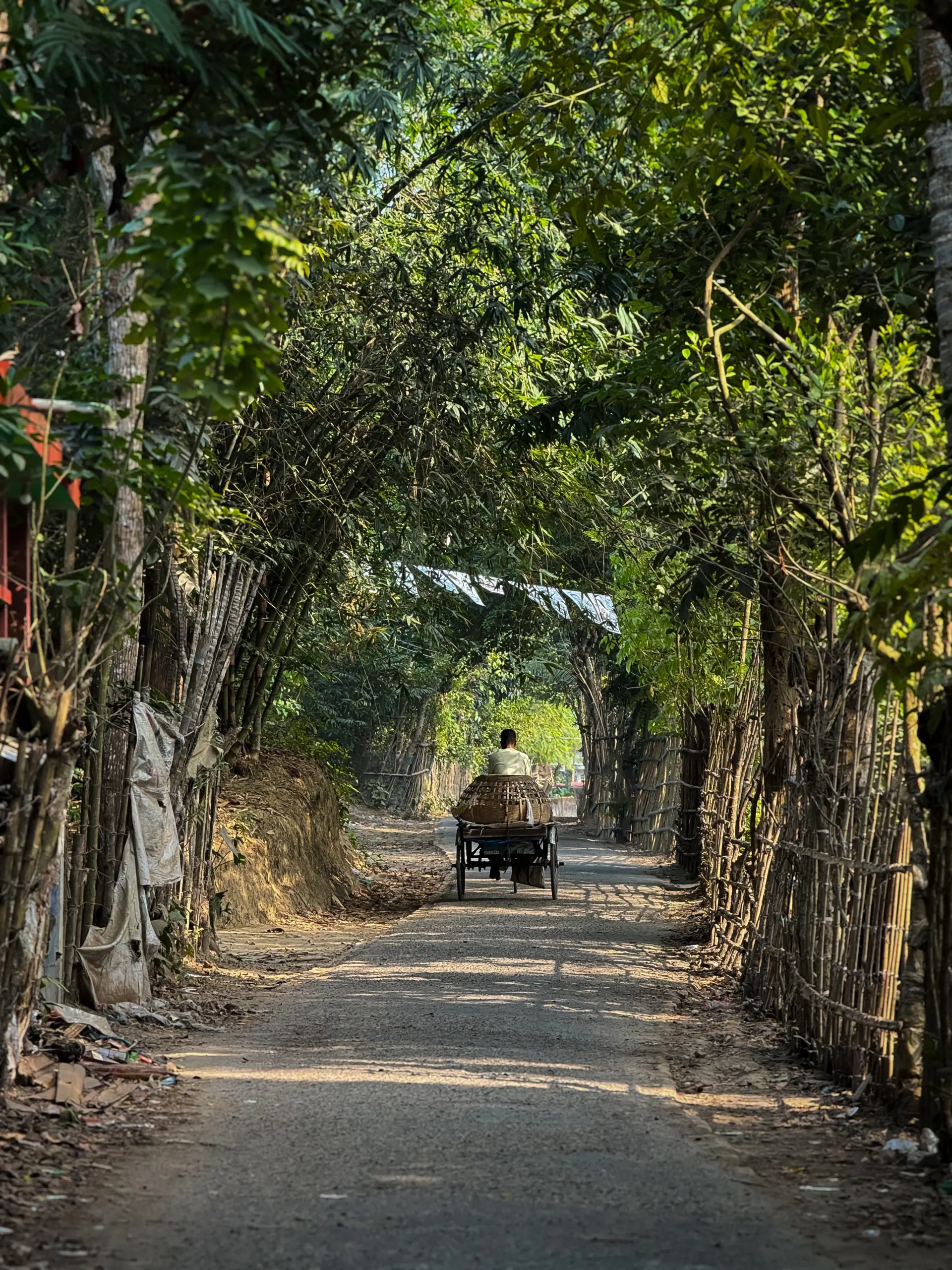Hinduism has really played a huge role in my life in helping me understand myself and the world around me. It’s really deep and I consider it an amazing spiritual tradition with thousands of years worth of accumlated knowledge.
It’s no doubt spurred a lot of my own growth in all aspects of life, not just spiritually. I’m still continuing to learn more about it (and other spiritual traditions such as Buddhism) but I definitely want to share what I have so far as well.
This blog post is a humble attempt to unravel some of the complexities of Hinduism. We’ll take a look at everything from its core principles and deities, to its sacred texts, and even how it’s practiced in different countries.
Along the way, we’ll explore essential concepts like dharma, karma, moksha, and the countless customs that make Hinduism such a beautifully diverse tradition.
My goal is to make Hinduism more accessible, more relatable, and less overwhelming. So, sit back, relax, and let’s explore the Sanatana Dharma!
Table of Contents
Toggle
What is Hinduism?
Hinduism is often considered more than just a religion – it’s a way of life. It’s also known as Sanatana Dharma or the “Eternal Way.” Hinduism emerged more than 4,000 years ago and is considered as the world’s oldest religion that’s still being practiced to this day.
But what makes Hinduism special is its diversity and openness. It doesn’t have a single founder, a specific theological system, a single concept of deity, or a single holy book, unlike many other religions.
Instead, it’s like a banyan tree with many roots and branches, each holding a unique philosophy, yet all interconnected. Or like the mighty Ganges river that has been fed by numerous streams over hundreds of years, growing and evolving, yet maintaining an unbroken continuity.
It’s this very diversity that makes Hinduism so multifaceted, accommodating a broad range of beliefs from monotheism and polytheism and even to atheism!
Who are the Deities of Hinduism?
In Hinduism, the divine can be found in multiple forms, and there are countless paths to seek and experience it. According to the Vedic texts there are 33 gods and according to the Puranas there are 330 million! But most Hindus believe that there is actually only 1 God with multiple manifestations.
If you want to learn more about the deities in detail and the debate on whether Hinduism is monotheistic or polytheistic, you can find my article on it here.
In the meantime, here are just of the most popular deities of Hinduism:
Brahma: Known as the God of Creation, Brahma is part of the Trimurti (Trinity), which also includes Vishnu and Shiva. He is often depicted with four faces representing the four Vedas.
Vishnu: Vishnu is the preserver and protector of the universe. He is known for his ten avatars, including Rama and Krishna (and even the Buddha!), which he assumes whenever the world is threatened with evil.
Shiva: Shiva is the destroyer or transformer in the Trimurti. He’s often depicted with a third eye on his forehead and a trident in his hand. Shiva is also known as the God of Yoga and Meditation, which is why you’ll often find his hands in the Gyan Mudra position. The featured image of this blog post is Lord Shiva!
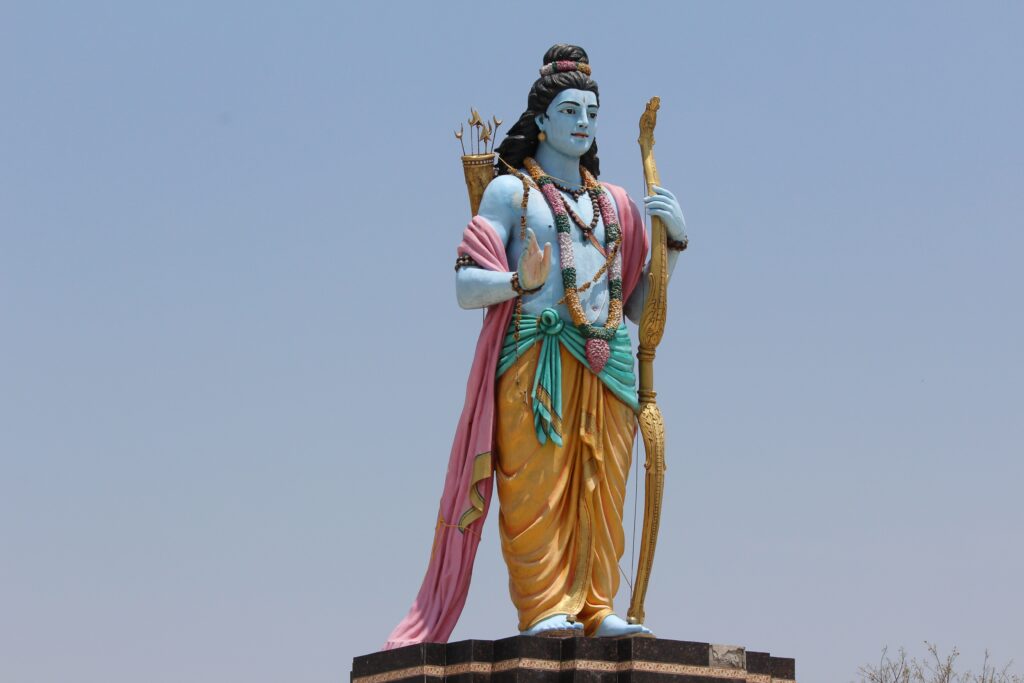
-
Lakshmi: Lakshmi is the goddess of wealth, fortune, power, luxury, beauty, and fertility. She is often worshipped for prosperity and is the consort of Vishnu. Sita, the wife of Rama, is one of her incarnations.
-
Ganesha: Recognizable by his elephant head, Ganesha is revered as the remover of obstacles and the god of beginnings and wisdom. He is also worshipped before starting any new venture.
-
Rama: An avatar of Vishnu, Rama’s life story is told in the epic Ramayana. He’s considered an ideal king, a just ruler, and a heroic warrior.
-
Krishna: Krishna, another avatar of Vishnu, is one of the most beloved deities in Hinduism. He is often depicted as a cowherd boy playing a flute. Krishna is the reason why cows are sacred in India!

-
Hanuman: The monkey god Hanuman is an ardent devotee of Rama and plays a crucial role in the Ramayana. He symbolizes strength, devotion, and perseverance.
-
Kali: Kali is the goddess of time, change, power, and destruction. She’s often depicted with a fierce expression, symbolizing her power to destroy evil.
-
Durga: Durga is a warrior goddess who combats evils and demonic forces that threaten peace and prosperity.
Sacred Texts of Hinduism
Hinduism is known for its vast collection of sacred texts and these texts are primarily divided into two main categories: Shruti (Heard) and Smriti (Remembered).
Shruti texts are those that are considered revealed, meaning they are believed to be divine in origin. While Smriti texts are those that are passed down through generations.
Shruti Texts
Vedas
The Vedas are the oldest and most significant scriptures in Hindu teachings. They are a collection of religious hymns composed in Sanskrit over the course of many centuries, beginning as early as 1500 BCE. The word “Veda” translates to “wisdom” in Sanskrit.
The Vedas are divided into four main categories:
-
Rigveda: This is the oldest and most important of the Vedas. It contains hymns praising a pantheon of gods that are personifications of natural phenomena, such as Agni (the fire god), Indra (the king of gods), and Varuna (the cosmic order).
-
Yajurveda: This Veda is more ritualistic in nature, providing the words that the priests use for the rituals. It is further divided into the “Black” and “White” Yajurveda, each with different characteristics.
-
Samaveda: The Samaveda consists of verses that are mostly from the Rigveda, but arranged in a specific order to be sung during rituals.
-
Atharvaveda: The Atharvaveda is different from the other three Vedas. It contains magical incantations, addressing simple, worldly concerns such as health, long life, prosperity, and love.
Each of the Vedas is further divided into two sections: the Brahmanas, which explain the hymns’ significance in the context of sacrificial rituals, and the Aranyakas, or “forest books,” which provide a bridge between the ritualistic Brahmanas and the philosophical Upanishads.
The Upanishads, considered the end part of the Vedas, elaborate on how the rituals and the chanting of the Vedas can lead to a greater understanding of life and oneself.
Smriti Texts
Puranas
The Puranas are a vast genre of important Hindu, Jain and Buddhist scriptures, providing insights on Hindu lore. Originating around 500 CE to 1500 CE, they contain narratives about the creation of the universe, genealogies of the gods, legends of the sages, and tales of royal dynasties.
There are traditionally 18 major Hindu Puranas, divided into three categories, each named after a deity: Brahma, Vishnu, and Shiva.
-
Brahma Puranas: These focus on the god Brahma, the rituals, and the details of dharma (righteous duty). An example is the “Brahmanda Purana,” which speaks about the universe and its creation.
-
Vishnu Puranas: Centered around Lord Vishnu, these Puranas generally promote the path of devotion (Bhakti) to Vishnu. The “Vishnu Purana” itself is a significant text in this category, outlining the ten avatars of Vishnu.
-
Shiva Puranas: These revolve around Lord Shiva and his consort Parvati. The most famous of these is perhaps the “Shiva Purana,” which narrates the stories of Shiva and his incarnations.
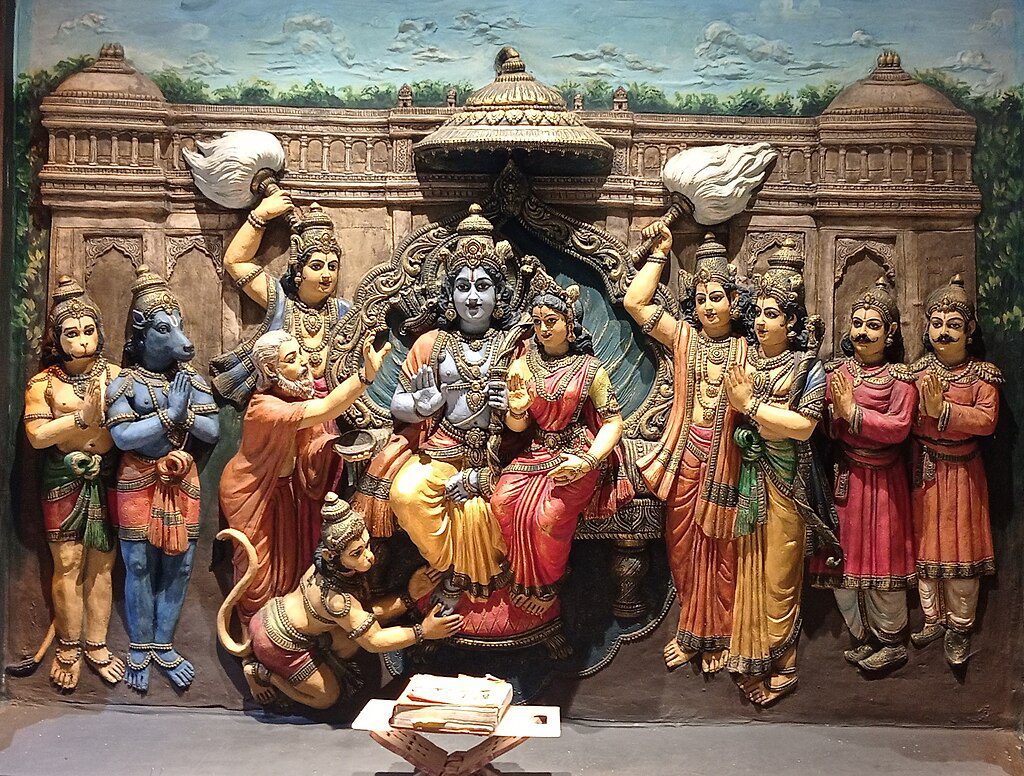
Ramayana
The Ramayana is my all-time favorite story! It’s one of the two major Sanskrit epics of ancient India, alongside the Mahabharata. It’s an epic narrative that consists of about 24,000 verses, traditionally divided into seven books.
The Ramayana tells the story of Rama (the seventh avatar of the god Vishnu). Long story short, the epic narrative details his royal birth, his years in exile, the abduction of his wife Sita by the demon king Ravana, and the resulting war to rescue her. You can read the full story here.
The Ramayana is much more than an exciting adventure story, though. It explores themes of dharma, relationships, loyalty, and the nature of good and evil.
Rama is held up as an ideal of virtuous living – the perfect king, the perfect son, the perfect husband, and even the perfect man.
The epic has had a profound influence not only in India but also other Southeast Asian culture. From the Thai adaptation of the Ramakien, the Wayang Kulit shadow puppetry of Malaysia or the Kecak Dance of Bali, the Ramayana is a cultural treasure of the world!
Mahabharata
Often described as the longest poem ever written, the Mahabharata has about 1.8 million words in total, spread across roughly 100,000 verses.
The epic tells the tale of the Kurukshetra War, a dynastic struggle for the throne of Hastinapura, a kingdom ruled by the Kuru clan. The two main branches of the Kuru clan, the Pandavas and the Kauravas, are the parties in the conflict.
More than just a story of war, the Mahabharata also encompasses a wide array of philosophical and ethical discussions, and just like the Ramayana, the Mahabharata’s exploration of dharma, relationships, power, and the human condition continue to resonate with the world to this day.
Bhagavad Gita
The Bhagavad Gita, often referred to simply as the Gita, is considered a spiritual classic! It’s part of the Indian epic Mahabharata (specifically, the 6th book called the Bhishma Parva) and is written in the form of a dialogue between Prince Arjuna and Krishna, who serves as his charioteer.
In the dialogue, Krishna provides Arjuna with guidance on how to deal with moral dilemmas and duties as a warrior. Arjuna is morally troubled about fighting in the Kurukshetra War, where he would be killing his own family members and teachers who are on the opposing side. Krishna ultimately advises Arjuna to uphold his duty as a Kshatriya (Warrior)
Krishna provides insights on a number of philosophical concepts, including the nature of the self, duty, and the paths to spiritual enlightenment.
He outlines various paths of spirituality including devotion (Bhakti Yoga), knowledge (Jnana Yoga), and disciplined action (Karma Yoga).

What are the Core Beliefs of Hinduism?
Dharma
Often interpreted as “duty,” “ethics,” “morality,” or “righteousness,” Dharma forms the moral foundation that guides life according to various circumstances.
The principle of Dharma dictates that every person has certain responsibilities they should perform to live a meaningful life. These duties may vary depending on their role in society. For example, a parent’s Dharma might involve caring for their children, while a student’s Dharma might focus on respecting their teacher and studying diligently.
This understanding of Dharma also influences the concept of Karma in Hinduism. Actions in line with Dharma are believed to accrue positive karma, leading to favorable outcomes in this life or the next, while actions that go against one’s Dharma are believed to generate negative karma and potential suffering. So what is Karma you might ask?
Karma
Karma in Buddhism and Hinduism are a bit different. In Buddhism, Karma is about the action while in Hinduism, it’s all about cause and effect. I’m sure you’ve heard of the saying, “What goes around, comes around.” The deeds you do, whether they’re good or bad, will come back to you in this life or the next.
Hindus also believe that Karma affects your current life, as well as your future lives. So, if you’ve been kind, you’ll experience positive returns. But if you’ve caused suffering, the universe will ensure you feel the consequences.
And here’s where it gets interesting: your Karma doesn’t just disappear when you die. Hindus believe in reincarnation, which means your Karma carries over into your next life. The kind of life you lead now could determine your future existence. It’s a cycle, and how you behave breaks or makes your cycle.
Samsara
Samsara is a Sanskrit word that roughly translates to “journeying.” It refers to the cycle of birth, death, and rebirth, a process that every being undergoes until they achieve Moksha, or liberation.
Think of Samsara like a wheel, constantly turning. Each life you live is like a journey around the wheel. But unlike a fun Ferris wheel ride, Samsara isn’t always enjoyable. Life is filled with challenges, suffering, and ultimately death. But it doesn’t end there, because after death comes rebirth and so it’s another round on the wheel.
The goal in Hinduism is to break free from this cycle. The idea is to lead a life so good, so enlightened, that you reach a state of understanding and peace that lets you hop off the wheel of Samsara. This is called Moksha.
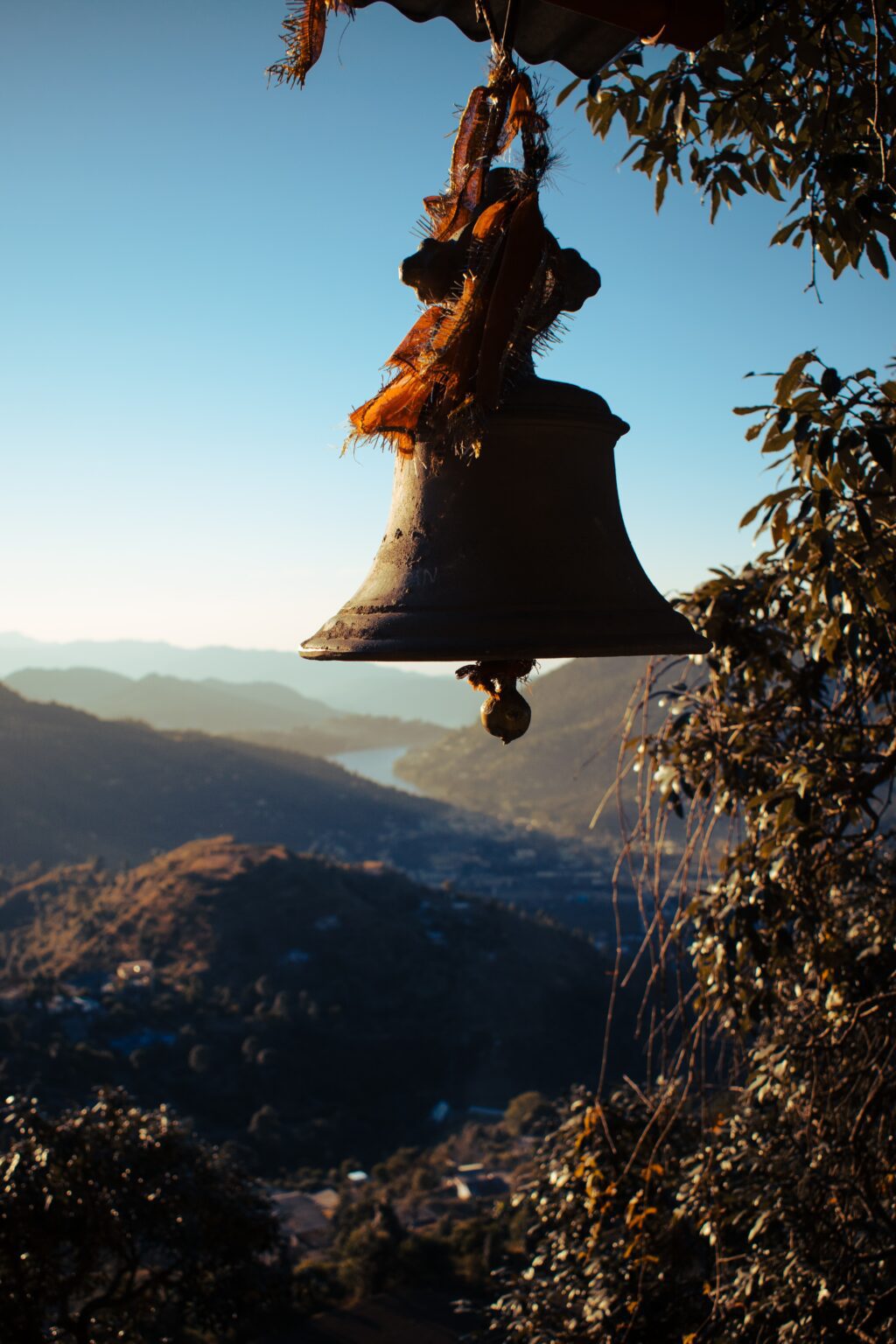
Moksha
Moksha represents the ultimate goal of human life – the liberation from Samsara. It’s a state of profound peace and bliss, where the individual soul (Atman) realizes its oneness with the ultimate reality, Brahman.
Now, maybe you’re thinking “Well, that sounds exactly like the Buddhist concept of Nirvana!” Here’s where it gets a bit tricky though. While Moksha and Nirvana might sound similar as in they’re both about liberation from suffering and the cycle of rebirth, they still have some subtle differences.
Buddhism doesn’t recognize the concept of an eternal soul or a universal reality. Instead, it sees the individual as a collection of changing states. Buddhism’s view of the “changing states” is closely tied to the concept of emptiness (Shunyata) which you can read more about here.
Basically, Moksha emphasizes realizing the soul’s oneness with the divine, while Nirvana emphasizes ending the illusion of the “self”.
Brahman
Not to be confused with the God of Creation, Brahma! Brahman is considered the ultimate reality. It is formless, infinite, and eternal, and is the source of all things in the universe.
Unlike gods in many other religions who are personalized, Brahman is not a “god” in the sense of a conscious being to be worshipped, but rather the fundamental reality underlying all objects and experiences. It is often symbolized by the ever-prevalent symbol of Om.
Everything in the world, from the tiniest organism to the planets, is considered to be a manifestation of Brahman. The ultimate goal of Hindu spiritual practice is to recognize the Brahman nature within one’s own self which is Moksha. Are you getting it now?
A famous line from the Upanishad: “Tat Tvam Asi” or “You are That” encapsulates the idea that Atman (You) and Brahman (That) as ultimately identical.
Atman
Atman refers to the individual soul. It’s the spiritual essence of each one of us, often conceived as eternal and divine. It’s seen as our true self, beyond identification with the phenomenal world of changing physical forms and fleeting experiences.
Atman is regarded as the essence of an individual, and its nature is often described as pure consciousness. It’s what observes and experiences our thoughts, feelings, and actions, but it itself is unchangeable and untouched by these worldly experiences.
Realizing the Atman as true nature is a key aspect of Moksha.
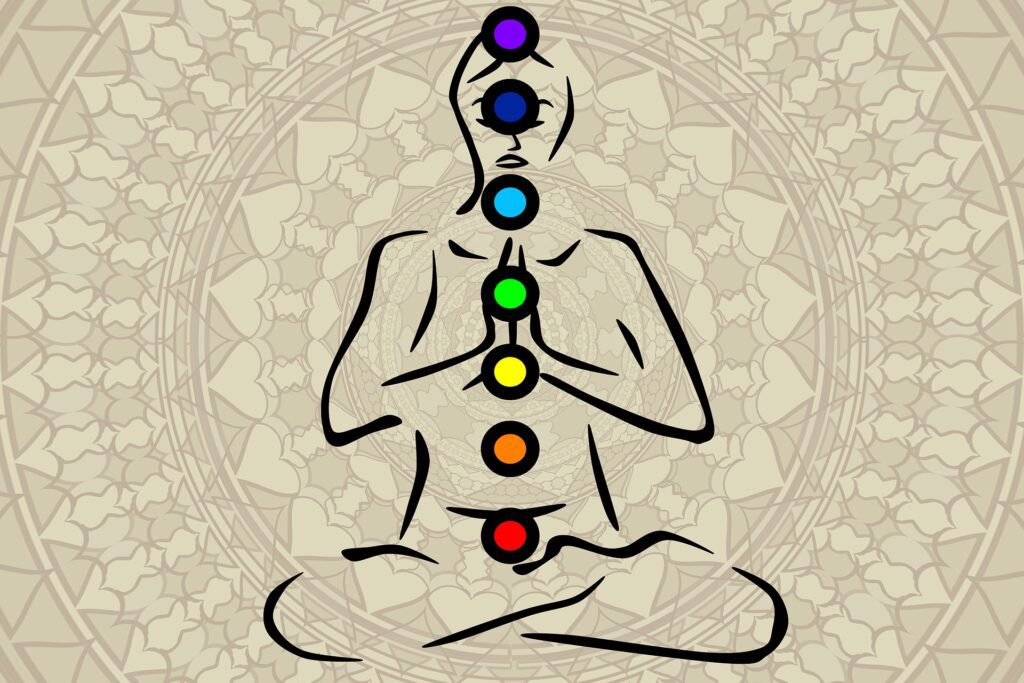
Chakras
The word “chakra” is Sanskrit for “wheel,” and it signifies one of seven basic energy centers in the body.
In Hinduism, the chakras are visualized as spinning wheels of energy or lotus flowers and are associated with different colors, sounds, elements, and deities. Each one is believed to regulate different aspects of the mind, body, and spirit.
The chakras, starting from the base of the spine to the crown of the head, are as follows:
- Muladhara (Root Chakra)
- Svadhisthana (Sacral Chakra)
- Manipura (Solar Plexus Chakra)
- Anahata (Heart Chakra)
- Vishuddha (Throat Chakra)
- Ajna (Third Eye Chakra)
- Sahasrara (Crown Chakra)
If you want to learn more about chakras, you can check out my article on it here.

What are the Core Principles of Hinduism?
Ahimsa
Ahimsa translates to “non-violence.” It extends beyond the physical act of violence, encompassing harm inflicted through words and thoughts as well. It’s the practice of kindness towards all living beings, not just fellow humans.
It’s why there are so many Hindus choosing vegetarianism as a way of minimizing harm to animals.
Satya
Satya means “truth.”
In simple terms, it means being honest in our words and actions. But beyond honesty, it’s also about being true to who we are, living in accordance with our deepest values.
Being committed to Satya also means seeking the truth in a broader sense, striving for a deeper understanding of ourselves and the world around us. It’s about recognizing the truth of the interconnectedness of all beings and the ultimate oneness of the universe.
Aparigraha
Aparigraha basically means “non-greediness.” It’s the concept of not holding onto things more than necessary and of leading a simple life that’s free from materialism.
Practicing Aparigraha is recognizing that obsession with possessions can create attachments that keep us from finding true happiness. It encourages us to take only what we need, to share generously with others, and to not be overly attached to our things.
Aparigraha also teaches us to let go of our rigid mental and emotional attachments that can cause suffering and prevent us from growing.
Like other Hindu principles, Aparigraha isn’t just a rule to follow, but a way of life that aims to bring us closer to spiritual realization.

Svadhyaya
Svadhyaya is basically introspection. It’s a concept that goes deep into the realm of spiritual self-realization.
Svadhyaya encourages us to look inward and self-reflect, promoting an understanding of our thoughts, emotions, and actions. This reflection can help us identify our strengths and weaknesses, leading to personal growth and development.
Svadhyaya also involves the study of the sacred texts such as the Bhagavad Gita which I highly recommend!
What are the Practices of Hinduism?
Hinduism is rich in rituals and practices, all aimed at fostering a spiritual connection, developing personal discipline, and promoting the wellbeing of oneself and others. Here are some of the key practices:
- Puja: Puja is the act of showing reverence to a god through a worship ritual whether it’s at home or at a temple.
- Meditation: The main goal of meditation (dhyana) is to calm the mind, gain clarity, and cultivate a state of peace. Different forms of meditation are practiced, such as mindfulness, transcendental, and mantra-based meditation, you can read more about the types of meditation here.

- Yoga: Going beyond the physical exercises often associated with it in the West, Yoga in Hindu philosophy is a spiritual discipline aiming to unite the individual soul with the Supreme Soul (Brahman). Yoga itself means “Union”! If you want to learn more about yoga and the different yoga styles, you can click here.
- Mantra Chanting: Hindus often chant mantras which are sacred sounds believed to have spiritual power. You can find 5 powerful Hindu mantras here.
- Fasting: Fasting is common and is seen as a way to purify the body and mind, develop self-control, and show devotion to the divine.
- Pilgrimage: Making pilgrimages to sacred site is another common practice. Some of the most renowned pilgrimage sites include the Ganges River, the city of Varanasi, and the temple complex in Tirupati.

Hinduism by Country
Hinduism, being the third largest religion globally, has significant influence in several countries. Here’s a brief overview of Hinduism’s presence in different parts of the world:
- India: India is the birthplace of Hinduism and remains its spiritual heartland. With over 79% of its population practicing Hinduism, India has the highest concentration of Hindus in the world.
- Nepal: Nepal is the only officially Hindu country in the world. Hinduism is practiced by about 81.3% of the population. The country is also home to Pashupatinath Temple, one of the world’s most significant Hindu temples.
- Indonesia: Hinduism in Indonesia is primarily found in its province, Bali, where it’s a form of syncretic religion called “Balinese Hinduism.”
- Cambodia: Although the majority of the population in Cambodia practices Theravada Buddhism today, traces of Hindu influence are evident the jungle temples of Siem Reap such as the majestic Angkor Wat, which was initially built as a Hindu temple dedicated to Vishnu.
- Thailand: Thailand is also predominantly Theravada Buddhist, but Hinduism has significantly influenced its culture and monarchy. For instance, the kings of Thailand have always been named after Rama, from the Ramayana and Hindu deities such Ganesha are widely revered. Elements of Hinduism can be found in many temples such as the amazing Wat Arun.

- Sri Lanka: Hinduism in Sri Lanka is primarily practiced by Tamils in the northern and eastern parts of the country. The prevalence of Hinduism in these regions dates back to ancient times when the island was under the rule of Tamil kings. Like Thailand, the worship of Ganesha is quite popular. I’ve seen his posters on the buses there. I think this is usually the case for Buddhist countries with a substantial elephant population.
- Singapore: The religion introduced to Singaporean culture by Indians who came to work and live on the island during the British colonial rule. Today, Hinduism is practiced by about 5% of the resident population. The country is home to numerous Hindu temples, including the impressive Sri Mariamman Temple, the oldest Hindu temple in Singapore.
- Malaysia: While the primary religion of Malaysia is Islam, Hinduism has significant influence, particularly within the Indian community, which makes up about 7% of the Malaysian population. If you’ve ever been to the Batu Caves, then you know that Hinduism is ingrained in Malaysian culture.
What are the Customs of Hinduism?
- When meeting someone, a common greeting is to fold your hands, as if praying, and say “Namaste”.
- Life cycle rituals (Samskaras) mark significant events in a person’s life, such as birth, coming of age, marriage, and death.
- In Hindu culture, elders are typically treated with great respect. Younger people often touch the feet of their elders as a sign of respect, a custom known as “Charan Sparsh.”
- In many Hindu temples, modest attire is appreciated. Covering your shoulders, chest, and knees is often a good rule of thumb. Remove shoes before entering a temple or a Hindu home.
- If you’re invited to eat with a Hindu family, it’s typical to wash your hands before and after the meal. Many Hindus eat with their hands, and it is customary to use your right hand for eating and serving food.


